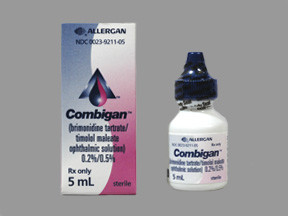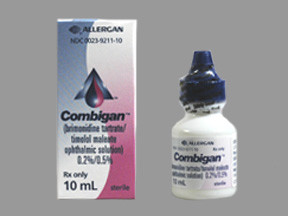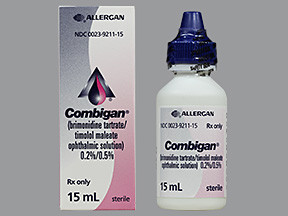BRIMONIDINE/TIMOLOL SOLUTION - OPHTHALMIC
PHONETIC PRONUNCIATION: (bri-MOE-ni-deen/TIM-oh-lol)
COMMON BRAND NAME(S): Combigan
GENERIC NAME(S): brimonidine tartrate/timolol maleate
Uses
USES: This combination medication is used to treat high pressure inside the eye due to glaucoma (open-angle type) or other eye diseases (e.g., ocular hypertension). Lowering high pressure inside the eye helps to prevent blindness. This product contains brimonidine and timolol. These medications are used together when 1 drug is not controlling the pressure inside the eye. Brimonidine works by allowing better fluid drainage from within the eye and also by decreasing the amount of fluid formed in the eye. It belongs to a class of drugs known as alpha agonists. Timolol is thought to work by decreasing the amount of fluid formed in the eye. Timolol belongs to a class of drugs known as beta blockers. This medication is not recommended for use in children less than 2 years old due to an increased risk of serious side effects. Ask the doctor or pharmacist for more details.
How to use BRIMONIDINE/TIMOLOL SOLUTION - OPHTHALMIC
HOW TO USE: This medication may come with a Patient Information Leaflet. Read the Patient Information Leaflet provided by your pharmacist before you start using this product and each time you get a refill. If you have any questions, consult your doctor or pharmacist. To apply eye drops, wash your hands first. To avoid contamination, do not touch the dropper tip or let it touch your eye or any other surface. The preservative in this product may be absorbed by contact lenses. If you wear contact lenses, remove them before using the eye drops. Wait at least 15 minutes after using this medication before putting in your contact lenses. Tilt your head back, look up, and pull down the lower eyelid to make a pouch. Hold the dropper directly over your eye and place 1 drop in the pouch, usually 2 times daily (12 hours apart) or as directed by your doctor. Look down and gently close your eyes for 1 to 2 minutes. Place one finger at the corner of your eye (near the nose) and apply gentle pressure. This will prevent the medication from draining away from the eye. Try not to blink and do not rub your eye. Repeat these steps for your other eye if so directed. Do not rinse the dropper. Replace the dropper cap after each use. If you are using another kind of eye medication (e.g., drops or ointments), wait at least 10 minutes before applying other medications. Use eye drops before eye ointments to allow the eye drops to enter the eye. Use this medication regularly in order to get the most benefit from it. To help you remember, use it at the same times each day. It is important to continue using this medication even if you feel well. Most people with glaucoma or high pressure in the eyes do not feel sick.
Side Effects
Precautions
Interactions
Overdose
Images
Reviews
Faq for BRIMONIDINE/TIMOLOL SOLUTION - OPHTHALMIC
Brimonidine/Timolol Solution - Ophthalmic is used to treat open-angle glaucoma or ocular hypertension (high pressure inside the eye).
This medication is a combination of two drugs, brimonidine and timolol. Brimonidine works by decreasing the amount of fluid produced in the eye, while timolol reduces the pressure in the eye by decreasing the production of fluid and increasing the outflow of fluid.
Follow the instructions provided by your doctor or pharmacist. Typically, one drop of the solution should be applied to the affected eye(s) twice a day. Avoid touching the tip of the dropper to any surface to prevent contamination.
Common side effects may include eye redness, stinging or burning sensation, blurred vision, dry eyes, or headache. However, inform your doctor if you experience severe or persistent side effects such as eye pain, swelling, unusual tiredness, or breathing difficulties.
It is essential to consult your doctor before using this medication if you are pregnant or breastfeeding, as the risks and benefits need to be evaluated on an individual basis.
If you miss a dose, apply it as soon as you remember. However, if it is close to the time for your next dose, skip the missed dose and resume your regular dosing schedule. Do not apply a double dose to make up for a missed one.
Certain medications, such as beta-blockers or monoamine oxidase inhibitors (MAOIs), may interact with Brimonidine/Timolol Solution. It is important to inform your doctor about all the medications, including over-the-counter drugs and herbal supplements, that you are taking.
Contact lenses should be removed before applying the medication and can be reinserted after 15 minutes of applying the solution.
The effects of this medication may be noticeable within a few hours, but it may take several weeks for full benefits to be observed. Continue using the solution as directed by your doctor.
Disclaimer
IMPORTANT: HOW TO USE THIS INFORMATION: This is a summary and does NOT have all possible information about this product. This information does not assure that this product is safe, effective, or appropriate for you. This information is not individual medical advice and does not substitute for the advice of your health care professional. Always ask your health care professional for complete information about this product and your specific health needs.



No Reviews Yet